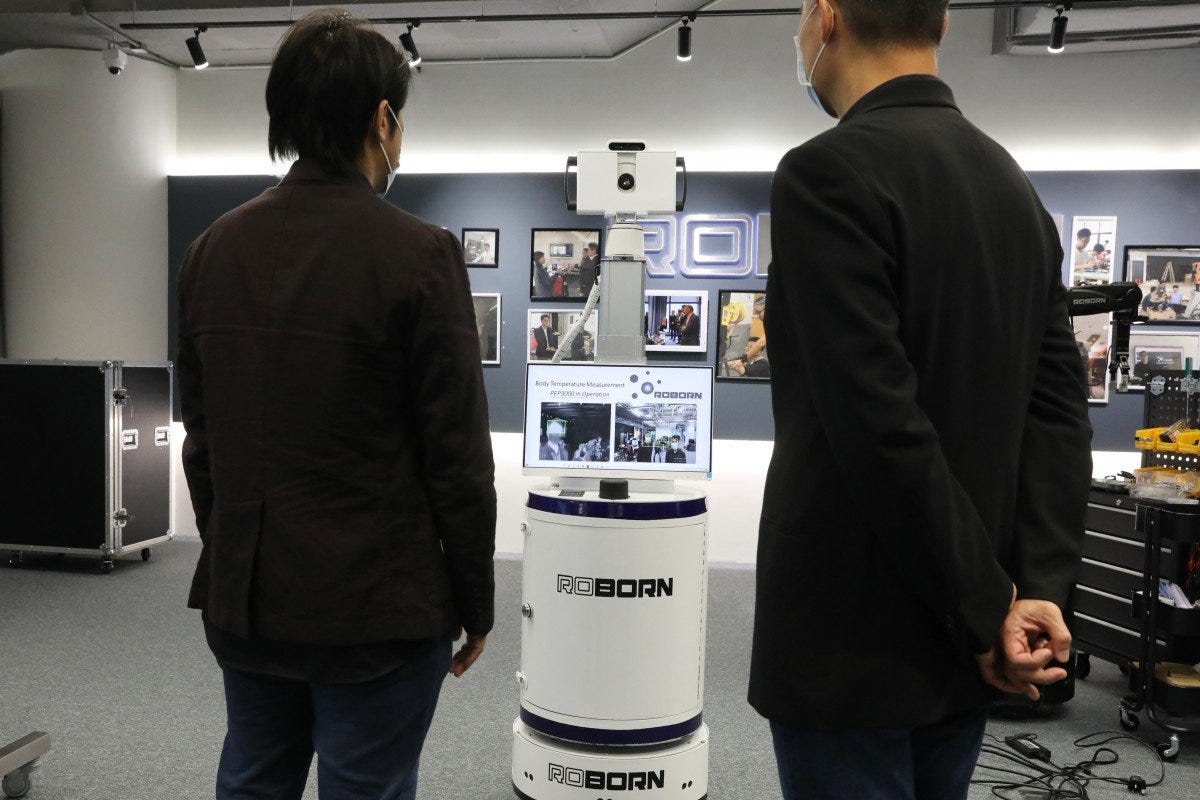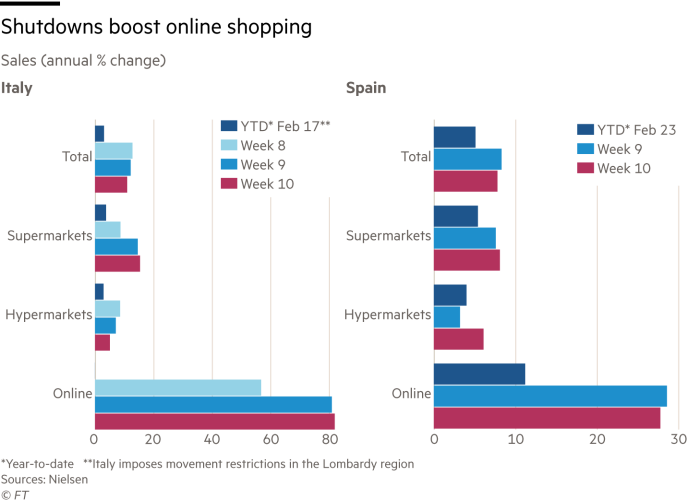Here’s your weekly wrap of technology, innovation, and finance news.
? Robotics and Drones
Police in Chula Vista, California and in Spain are resorting to using drones equipped with loudspeakers and cameras to help enforce coronavirus lockdowns. Drones were previously used in China for the same purpose.
Microsoft researchers have written a paper on how to teach an AI to fly a real-world drone by training it in a simulation.
The coauthors assert that the results show “great potential” for helping in real-world applications. For example, the system might help an autonomous search and rescue robot to become better able to recognize humans despite age, size, gender, and ethnicity differences, giving the robot a better chance of identifying and retrieving people in need of help.
Business is good for Roborn Technology, a Hong Kong startup that makes temperature-taking robots. The company is expecting orders for 50 to 100 units in Hong Kong and Macau, mostly for high-specification units priced above HK$400,000 each (above US$51,000 or A$88,000 each).
Standard University has developed semi-soft robots that use inflatable tubes to move. Their paper highlights the advantage of their design over pneumatic robots.
There are numerous advantages to a design like this. You get all the advantages of pneumatic robots (compliance, flexibility, collapsibility, durability, high strength to weight ratio) without requiring some way of constantly moving air around, since the volume of air inside the robot stays constant. Each individual triangular module is self-contained (with one tube, two active roller modules, and one passive anchor module) and easy to combine with similar modules—the video shows an octahedron, but you can easily add or subtract modules to make a variety of differently shaped robots with different capabilities.
? Working from Home
Zoom featured in the news last week as more people work from home. CNBC wrote about why Zoom has become the darling of remote workers and how the company is handling the increased demand. Cisco’s Webex service is also seeing record usage. The New York Times highlighted the rise in trolling in public video conferences (“Zoombombing”) and how Zoom usage has extended beyond work to schooling, parties, and memes.
But no amount of planning could have anticipated the company’s emergence as a cultural phenomenon used to host parties, concerts, church services and art shows. Zoom could not have prepared to become a meme.
A Facebook group for young people trapped at home called Zoom Memes for Self Quaranteens, founded less than a week ago, has already grown to more than 150,000 members.
Some people are even getting married on Zoom.
The WSJ looked at how America’s shut-in families are spending their days: Zoom, CNBC, and jigsaw puzzles.
An even bigger jump in viewership went to CNBC as markets moved downward, with a 244% increase in daily time spent watching the business network this week compared with a year ago, according to Samba TV.
Slack and Microsoft Teams also reported big usage increases as more people work from home. Slack added 7,000 paying customers since the start of February, which is 40% more than it normally adds in an entire quarter. Microsoft Teams reached a new record 44 million daily users, up from 20 million daily users just four months ago.
“This may have jump-started the market by seven years,” said Wayne Kurtzman, an analyst at tech research firm IDC. Forcing millions of people to change their everyday work practices “is a perfect opportunity for companies to become the digital businesses they have wanted to be”, he added.
? Gaming
Verizon saw a 75% increase in gaming traffic during the week ending March 16 compared to the week before as more people stayed home.
Activision’s new free-to-play battle royale shooter Call of Duty: Warzone reached 30 million players “working from home” in its first 10 days.
VR game Beat Saber surpassed 2 million copies sold. It’s a great game.
Beat Saber is one of virtual reality’s biggest hits, and the laser-sword rhythm dancing game has now reached a major sales milestone. Developer Beat Games Studiorevealed today on Twitter that Beat Saber surpassed 2 million copies sold. Fans have also purchased more than 10 million songs as downloadable content.
Valve CEO Gabe Newell thinks we’re way closer to The Matrix than people realise.
▶️ Streaming
Twitch saw its daily concurrent viewers rise 12% in March, its biggest year-over-year increase since August 2019.
Music is not necessarily a beneficiary of staying at home, with Italy seeing a decrease in the time spent streaming music.
In Italy, one of the countries hardest hit by coronavirus, the top 200 most streamed songs on Spotify within the country averaged 18.3 million total streams per day in February 2019. Since Italy’s prime minister announced a national quarantine on March 9th, the total streams for the 200 most popular songs have not topped 14.4 million. There was a 23% drop in top 200 streams on Tuesday March 17th compared to Tuesday, March 3rd.
With more people staying home and streaming video, YouTube, Amazon, and Netflix have cut picture quality in Europe to reduce the strain on the internet.
“Netflix has decided to begin reducing bit rates across all our streams in Europe for 30 days,” the company said. “We estimate that this will reduce Netflix traffic on European networks by around 25 per cent while also ensuring a good quality service for our members.”
?️ Ecommerce
Amazon is hiring an additional 100,000 employees in the US as millions of people turn to online deliveries. As of December 31, Amazon employed 798,000 full-time and part-time employees globally.
Delivery technology helped Chinese cities get through coronavirus.
The combination of consumer digital maturity and digitally supported supply chains has enabled local residents to organize home delivery of essential supplies to people in self-quarantine. In the gated communities and neighborhoods that characterize Beijing, for example, residents have organized small groups of volunteers via group chat apps to receive supplies at the gate for the whole community, box them for each household, and deliver them to people’s doorsteps.
Southern Europe has been slow to embrace ecommerce, but life under quarantine may help accelerate adoption with retailers like Carrefour in Italy seeing their online customers double.
⚙️ Mobility
Starsky Robotics, an autonomous truck startup, has shut down. The founder wrote a post outlining what went wrong; chief among them is the belief that “supervised machine learning doesn’t live up to the hype”.
Goodyear are working on intelligent tires outfitted with sensors and proprietary machine-learning algorithms that they hope will help self-driving cars brake at a shorter distance.
For example, if the tire senses that the car is driving over a slick road in cold temperatures, the vehicle will be able to automatically slow down and avoid sudden steering movements, while factoring in the tire’s tread and wear. Recent experiments showed that self-driving vehicles using Goodyear’s intelligent tires can shorten the stopping distance lost by wear-and-tear on a tire by about 30%.
Optical phased arrays could be a promising new technology for solid-state lidars in autonomous vehicles and for augmented reality headsets.
Researchers led by Columbia Engineering Professor Michal Lipson have developed a low-power beam steering platform that is a non-mechanical, robust, and scalable approach to beam steering. The team is one of the first to demonstrate low-power large-scale optical phased array at near infrared for autonomus navigation. It also claimed to be the first to demonstrate optical phased array technology on-chip at blue wavelength for augmented reality.
? Health
The Trump administration has expanded access to telemedicine in Medicare which is leading to more people trying it out.
For many of them, including the UC San Francisco cardiologist Ethan Weiss, the experience has been a pleasant surprise.
Telemedicine was “waaaaaaaaay better than I thought,” he told CNBC.
Hospitals are turning to technology to help manage patients, with Tampa General Hospital in Florida using facial scans to detect feverish visitors and Sheba Medical Center in Ramat Gan, Israel using AI-powered monitoring equipment to treat Covid-19 patients.
That sensor, which sits under a patient’s mattress, works by using machine learning to filter and analyze patterns in a person’s heart activity, respiratory rate and body movement and send early-warning alerts to medical staff members about deteriorating conditions.
Scientists have genetically modified nerve cells to produce an enzyme on their surface that joins together small molecules to make a polymer that can act as an electrical conductor or insulator. These modified cells could help us better connect to implants.
The work, which promises to allow electrical control of specific groups of cells, could lead to everything from new treatments for conditions such as epilepsy to better ways of connecting prosthetic limbs to nerves, says Zhenan Bao of Stanford University in California. “Those are definitely possibilities,” she says.
? Chips and Computing
Intel is releasing a neuromorphic computing system called Pohoiki Springs that can apparently train machine learning models with far greater energy efficiency than traditional computers.
Unlike in traditional machines, in the Pohoiki Springs system, the memory and computing elements are intertwined rather than separate, Mr. Davies said. That minimizes the distance that data has to travel, because in traditional computing architectures, data has to flow back and forth between memory and computing, he said.
Intel researchers recently used a single neuromorphic research chip to train an AI system to recognize hazardous odors using one training sample per odor, compared to the 3,000 samples required in state-of-the-art deep-learning methods—therefore requiring a fraction of the energy.
? Finance
The S&P 500 fell 15% over the week. It has now fallen 32% since its recent peak on the 19th of February.
Square got approval to start its own bank in Utah which will pave the way for them to start offering small-business loans to merchants.
⚡ Other Snippets
Ultrasonic waves, which pass through solid objects like walls, could be used to hack your phone by tricking voice assistants into making calls or revealing compromising texts.
Researchers have previously demonstrated how they could trick a phone by sending these waves through the air, but the approach required proximity to the victim and was easily disrupted by nearby objects. Now a new technique called SurfingAttack can send ultrasonic waves through solid objects. It could enable potential snoops to avoid obstacles and perform more invasive tasks—including stealing text messages and making calls from a stranger’s phone.
Hong Kong is using electronic tracker wristbands to geofence people under coronavirus quarantine.
Thousands of computers that were mining Ethereum have been redirected towards helping coronavirus research through Stanford University’s Folding@home project.
Apple’s new iPad Pro includes a lidar scanner that can scan objects in 3D.
Kurzgesagt produced a video explaining what coronavirus does to you, and what you should do to combat it.







